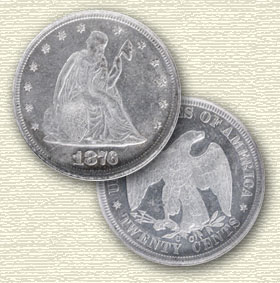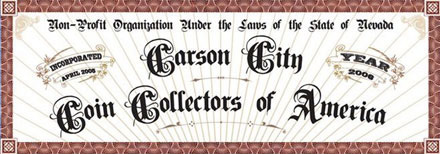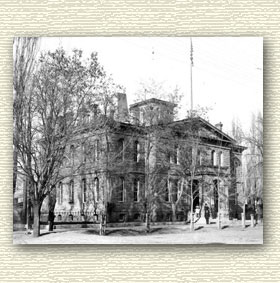- Posts: 499
- Thank you received: 0
1871-CC 10C Carson City Coin of the Week 8/21/2011
POPULATION AND PRICING
PCGS Census: The company has certified forty-three examples of the 1871-CC Dime, only two of which are Mint State. The company has graded five coins from AU-50 through AU-55 with the 36 remaining coins residing in FR-2 through XF-45 holders.
PCGS Price Guide: I have included Mint State prices only for the two grades in which PCGS has actually certified examples of the 1871-CC Dime.
PCGS Price Guide
2 to 10 = 1,500 - 3,900
12 to 15 = 6,250 - 7,000
25 to 35 = 11,000 - 14,000
40 to 45 = 16,500 - 19,000
50 to 53 = 21,000 - 25,000
55 to 58 = 30,000 - 50,000
MS 63 = 110,000
MS 64 = 160,000
NGC Census: The company has certified twenty-two examples of the 1871-CC Dime. Six of these are Mint State examples of which two are graded MS-61, two are MS-62 and two are certified at the gem level grade of MS-65.
NGC Price Guide: NGC provides somewhat less detailed pricing information. Seemingly blatant is their omission of a price estimate for MS-65 since NGC has certified two examples of the 1871-CC Dime in this gem grade.
NGC Price Guide
AG to G = 1,400 - 1,740
VG to F = 3,330 - 6,420
VF to XF = 8,500 - 12,420
50 to 53 = 22,810 - 25,000
55 to 58 = 33,440 - 40,630
60 to 61 = 54,380 - 60,630
MS 62 = 68,130
MS 65 = no price given
A FEW RECENT SALES
Grade Price Date Sale
NG $1,495 Aug-2011 Heritage 2011 August Chicago Signature US Coin & Platinum Night
AU50 - $21,850 Mar-2011 Heritage Sacramento Signature ANA Auction
AU55 - $27,600 Sep-2010 Heritage Long Beach, Signature Auction
NG - $1,840 Sep-2010 Heritage Long Beach, Signature Auction
AG3 - $1,495 Sep-2010 Heritage Long Beach, Signature Auction
1871-CC DIME - TYPE
The 1871-CC Dime, with the legend "UNITED STATES OF AMERICA" on the obverse, is most frequently described as the 4th Variety" of Seated Liberty dime. For those type collectors who like to cut finer lines between varieties, the 1856 resumption of the 2nd variety could technically be called the 4 variety of Seated Liberty dime, making the 1871-CC dime a member of the 5th generation of this venerable series. All told, there are up to seven varieties of the Seated Liberty dime series, depending on one's definition of what makes a coin a different "type" or variety form its brethren. Other than these purposeful design changes, there are no other minting process related varieties of the 1871-CC dime.
1871-CC DIME - A SEMI-KEY COLLECTIBLE
Even discounting the unique, 1873-CC Without Arrows dime, the four years of dime coinage from 1871 through 1874 at Carson City include some of today's most sought after rarities. While not the absolute rarest of this small group, the 1871-CC dime exists in only slightly higher numbers than the 1873-CC and 1874-CC dimes. Consider the following; Louis Eliasberg's famous type collection included three 1871 Seated Liberty dimes. His 1871 Philadelphia minted dime was graded Proof 63. His 1871-S example was graded MS-65. But his 1871-CC dime was only AU-50!
With less than 25 certified examples combined, inclusive of all remaining XF, AU and MS graded coins, the 1871-CC dime must be considered one of the most important, semi-key dates within the Carson City coin series.
Belay Off
C4OA Lifer!
Please Log in to join the conversation.
To piggy-back on Drummer's comment, is the proof or specimen 1871-CC dime accounted for in a collection?
Gar
Please Log in to join the conversation.
- coindrummer
-

- Offline
- Platinum Member
-

- Michael D. Parrott
- Posts: 775
- Thank you received: 0
May I commend you on yet another fab COW post of one of the great "CC" rarities...the 1871-CC seated dime. Again, you have done a ton of research and your post reflects that.
I didn't realize that surface porosity was so prevalent on the most of the early "CC" dime issues until I read your post. Now that I think of it, I have never really seen (or held) one of these rarities that didn't exhibit this trait.
I do hope that someone out there has a picture of the elusive "proof" 1871-CC dime...I'd love to see it. meanwhile, the pics you provided show some beauties....I especially love the toning on the "yeoldeone" example.
Thanks again for another superb post
the drummer
C4OA Lifer!
Please Log in to join the conversation.
- maryelise8863
-

- Offline
- Premium Member
-

- Riding the COATTAILS of my dad!
The knowledge you have, and the research you do, for these articles makes my head hurt. You guys are incredible!
I always hated this line, but here goes... "When I win the lottery..." I promise to become a genuine CC collector! Until then I'll just have to admire all of you.
Mary Elise/Coattails
Mary Elise
Please Log in to join the conversation.
You took on the challenge of writing an article about an extremely rare-date issue from the Carson City Mint with full-on passion. Your enthusiasm for your subject comes through loud and clear. I know that anyone who reads your COTW posting will come away from the experience with a fuller appreciation of the elusive 1871-CC dime.
You quoted me from TMOCS
I have to say that once upon a time, when I groped for answers to explain the many mysteries about "CC" coiange, and found very little information published about the Carson Mint and its coins, I was at the mercy of researchers like Walter Breen, circumstantial evidence, and my own conjectures. (By the way, I'm still groping for answers.)Despite the potentially high demand for dimes in 1871 within the Comstock region, Rusty Goe explains, in The Mint on Carson Street, that nearly 90% of all silver coinage produced at Carson City was stored, and not released to the public.
I don't have absolute proof that the Carson City Mint withheld large percentages of its silver coin production from the early years. Breen said this was the case, although he did not cite his sources.
The meagre survival populations suggest that this theory could be true. On the other hand, since a dime was the smallest denomination used in northwestern Nevada at this time, it is possible the demand for every piece the Carson City Mint could supply would have necessitated release of all ten-cent pieces.
As you pointed out, political chicanery, which we know influenced decisions about the Carson City Mint, and brought in question its usefulness to the nation, must also be weighed in. Researchers and collectors will be debating this topic forever.
You wrote:
Actually, you did find images of this coin. It is the coin pictured three paragraphs below in your article, the one in Yeoldeone's collection. Mr. Yeoldeone bought this piece in Bowers & Merena's March 2005 sale for $230,000. In January 1990, it sold in Stack's sale of a portion of the James A. Stack collection for $50,600.This 1871-CC dime is known as the Stack Specimen, graded a whopping MS-65 by NGC.... Try as I might, I was not able to locate a photo of this fabulous coin. However, I will leave the space below open in case someone else does have an image of this coin and is willing to send it to me so I can add it to this article.
The Stack's cataloguer described it as follows: "A wholly prooflike example, sharply struck and cameo-like. In fact, without looking for the mintmark, one could be easily lulled into thinking it is a Proof!" I guess I was lulled into believing this was a possiblity.
B. Max Mehl, one of the most prominent rare coin dealers and auctioneers of the first half of the 20th century, also believed an 1871-CC dime, which he sold in his Will W. Neil auction in June 1947, was a Proof specimen. He described it in part as follows: "A beautiful proof specimen, wire edges on reverse." The winning bidder paid $217.50 for it. We don't know if James A. Stack bought the dime in that sale, but this was certainly the time he was building his world-class collection (Unfortunately, there's no picture of the 1871-CC dime in the Neil catalog, so we can't compare it with the Stack (Yeoldeone) coin).
But anyway, you had the picture you were looking for, right under your nose. By the way, I have taken criticism for my saying that the Stack 1871-CC dime is a Proof or a Specimen strike. Likewise, Mehl, who had a reputation of calling many coins Proofs, just because he was awed by their appearances, has been bashed too. And I'm sure the cataloguer at Stack's in 1990, received his share of snarling scorn for his description of the Stack 1871-CC dime. We all do the best we can with the resources available to us.
You wrote:
This coin eventually upgraded to AU-53. It has prooflike surfaces and a bold strike, and although it is not in the same class as the Stack-Yeoldeone specimen, it is a beauty.Louis Eliasberg's ... 1871-CC dime was only AU-50!
Once again, your COTW essay stimulated all of us who read it. Great job!
Rusty
C4OA Lifer!
Please Log in to join the conversation.
- Loosechange
- Offline
- Platinum Member
-

- Married to my best friend!
- Posts: 504
- Thank you received: 0
Loosechange
Go "CC'S"
Please Log in to join the conversation.



